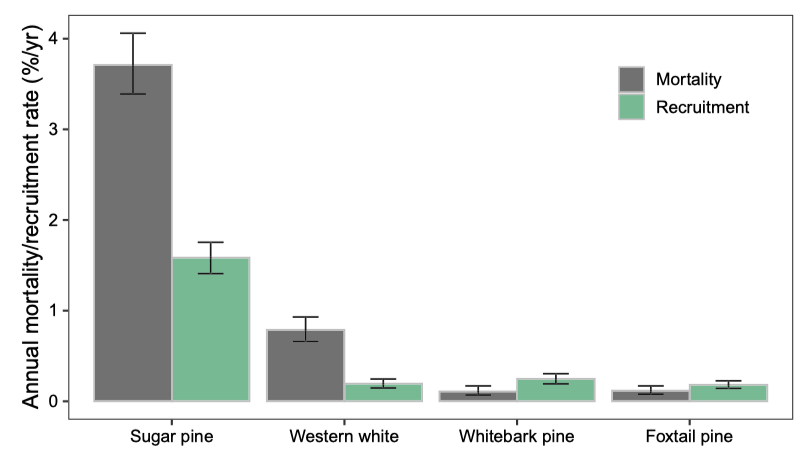Outreach
Google Earth Engine Community Tutorial
UPDATE!
I turned the tutorial below into the Zonal Statistics book chapter in the open source book, Cloud-Based Remote Sensing with Google Earth Engine, published October 2023. You can find it at that link if you go to the book, Section F5, as chapter F5.2. Huge thanks to my coauthor Justin Braaten!
Original tutorial released February 23, 2021
https://developers.google.com/earth-engine/tutorials/community/extract-raster-values-for-points
Almost every ecologist I know has at some point wanted or needed data from a raster file such as elevation, slope, or NDVI, and many people I know work with plot data as well. Extracting those raster values for plots is therefore a pretty essential research task. I knew how to do this in a variety of ways (R, ArcMap, ENVI), but when I realized I needed a time series of reflectance data for my plots across many years, I decided to use Google Earth Engine - it would have been incredibly cumbersome to download all the imagery locally.
After a bit of time puzzling over it on my own and with the help of a friend, I met the Google engineer Justin Braaten at a workshop during the AGU conference. Over the next year (with some starts and stops…) we figured out the best way to get the code working and ways to apply it to a variety of purposes and datasets. I wrote a community tutorial for the code because this is a crucial task, Earth Engine is the perfect platform for it, and there wasn’t good documentation about it. If it took a Google engineer a lot of thought and time to figure it out, I wouldn’t expect my peers to be able to figure it out quickly. And as a bonus, I learned a lot about Earth Engine as I figured out explanations!
The tutorial goes through the ideas and code for the basics of extracting raster data for points or polygons, and then three examples. If this is relevant to your work, I encourage you to take a look, try it out, and let me know how it goes! It’s all on github, so I am happy to take suggestions for improvement and clarity.
California Fire Science Consortium research brief
Released May 2021
https://www.cafirescience.org/research-publications-source/category/whitepinemortality
Disturbance interactions are a fascinating topic, so I was very excited to read the paper that Joan Dudney and others wrote about the multiple disturbances that white pines face in the southern Sierra Nevada. I wrote a research brief for the California Fire Science Consortium (which has lots of other great briefs too!) so there would be an easy-to-read summary of their study, the findings, and the importance for management.
Key findings relevant for management:
- The extent of white pine blister rust increased from 20% of plots in
the 1990s to 33% of plots when resampled ~20 years later.
- The blister rust infection rate declined in sugar pine due to the
already very high rate of mortality in sugar pine from earlier
infection. Sugar pines also had high amounts of mortality from fire and
mountain pine beetle, which all together led to a more rapid decline in
sugar pine populations than had previously been documented. Sugar pines
may need active restoration in the southern Sierra Nevada to sustain
their population.
- Infection rate of blister rust increased in western white pine and whitebark pine. While no infections were found in plots with foxtail pine, white pine blister rust was observed in foxtail pines outside of the plots for the first time.
- Within each species, lower elevations were associated with increased
mortality; these are also the areas most at risk from climate warming
impacts.
- More frequent sampling of long-term monitoring plots is needed to track mortality, especially in the subalpine white pines in the southern Sierra Nevada.
Figure shows the annual mortality (grey bars) and recruitment rates (green bars) by white pine species. Error bars represent 95% confidence intervals.
 Source: Dudney et
al. 2020, Ecosphere
Source: Dudney et
al. 2020, Ecosphere
Climate change solutions
I gave a few guest lectures Dr. Marina Oster’s Stanford continuing education classes on climate change solutions and developing climate change action plans. I gave lectures on fire ecology and being zero waste (a practice I followed for a few years).
The section on fire includes the following topics:
Fire ecology basics
Fire regimes
California fire
Fire-adapted ecosystems and the history of cultural fire by Indigenous people
Fire suppression
The current issues
Moving forward: prescribed fire, home-hardening, and climate change